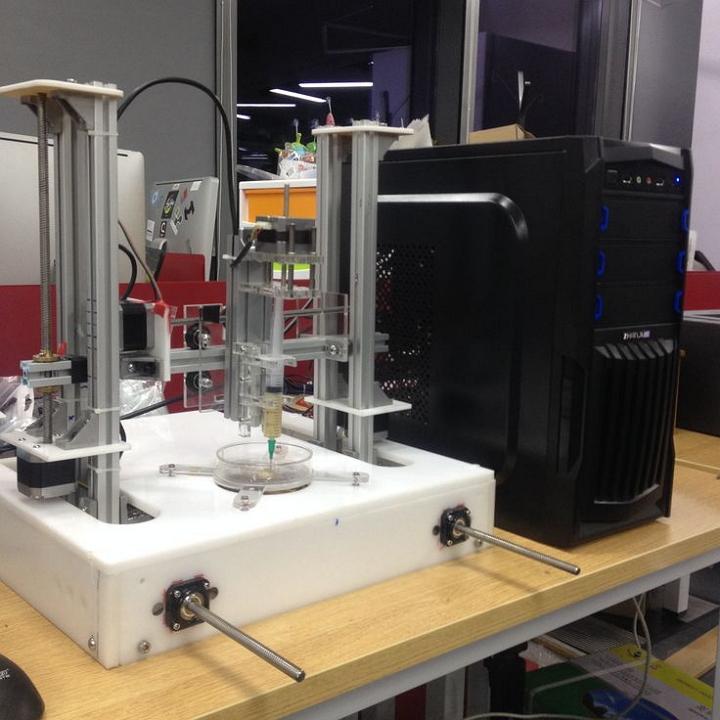 The founder of Ouro_botics, Jemma Redmond, was working on her masters thesis about four years ago – a tome entitled An Investigation into Osteoblast Adhesion — when she discovered bioprinting. In Dublin, around her kitchen table, her company came to fruition.
The founder of Ouro_botics, Jemma Redmond, was working on her masters thesis about four years ago – a tome entitled An Investigation into Osteoblast Adhesion — when she discovered bioprinting. In Dublin, around her kitchen table, her company came to fruition.
“One particular application was cell adhesion, and so I set out to create some ECMS (extra cellular matrices, or scaffolds) and grow some osteoblasts (bone) on the scaffolds,” she says. “Having a limited budget, I went off and bought a number of 3D printers and started modifying them into 3D bioprinters. However, I was subsequently told that my budget had been cut rather significantly by the university where I was studying. Being not a very happy bunny I decided to print some fingers for my scaffolds.”
As she began to realize that a bioprinter could open up interesting possibilities and applications, she says that sold her own businesses and started building her own printers testing out different configurations and methods, and Ouro_botics was formed to build an affordable, modular bioprinting platform for students, biohackers and researchers.
“After months of hard work,” Redmond says of Ouro_botics, “we built a 10 micron accuracy bioprinting platform that can be fitted with different types of extruder heads and allows researcher to try out different biomaterials such as gelatine, alginate, chitosan, keratin with different extrusion methods.”
She says the bioprinting is more than a single technique with one material and one application; it’s many techniques, many applications and many materials. The key is to have a machine that can be readily adapted. To build the proper system, she and her team printed simple copies of finger bones with cells, reproductive systems and carcinomas with simple materials and through that process, they learned what would be required of a hardware solution.
As for what the company is focusing on now, Redmond says “augmented tissue” is a point of interest.
“Why make a copy of the same thing, the same organ, when you can literally, make it better? Stronger, more efficient, longer lasting, perhaps with embedded sensors to give you an idea of whats going on inside your body,” Redmond says of the concept. “It sounds like science fiction, but it is certainly doable. And biomimicry is a subject as a scientist that interests me greatly. We can solve a lot of engineering problems by looking to what we can find in nature. And thus we can perhaps do the same with our own bodies.”
According to Redmond, the future holds the promise of human tissue arrays which will be used for drug testing, and those constructs will result in cheaper, better drugs to treat all manner of ailments. 
“With lab grown human tissue for testing, we can reduce and eventually eliminate the need for animal testing,” she says.
But she adds that she’s convinced the major issue facing development in bioprinting isn’t so much the efficacy of the technologies themselves,but rather the pace of regulatory approvals.
Redmond says that Ouro_botics is an alumni outgrowth of the Haxlr8r accelerator in Shenzhen, China, and part of the SOSVentures Group headed by entrepreneur Sean O’Sullivan. Working alongside Dr. Tony Herbert, the Financial Director of Ouro_botics, the company is busy navigating the entrepreneurial climate in China.
Hebert has a background in Plasma Physics and engineering, and he’s also currently the CEO of Irish Precision Optics, a manufacturer of optical components for customers such as the European Space Agency.
What do you think about upstart bioprinting concerns like Jemma Redmond’s Ouro_botics? Let us know in the Ouro_botics forum thread on 3DPB.com.
Subscribe to Our Email Newsletter
Stay up-to-date on all the latest news from the 3D printing industry and receive information and offers from third party vendors.
You May Also Like
Human Remains Could Be Identified with the Help of Forensic 3D Printing
I’m still in awe at what additive technologies can accomplish, from creating alternative meats, automotive parts, shoe insoles, and surgical models, to giving faces to the lost. That is to...
3D Printing News Briefs, May 17, 2023: Stress-Resistant Alloy, 3D Printed Trophies, & More
In today’s 3D Printing News Briefs, we’re starting off with a little research, as materials scientists developed a 3D printing process that produces an extremely stress-resistant alloy. Moving on to...
On the Ground with COBOD Construction 3D Printing at Ohio State
This winter, The Ohio State University’s Center for Design and Manufacturing Excellence (CDME), which is one of the country’s largest additive research groups, received a COBOD BOD2 3D construction printer...
3D Printing Webinar & Event Roundup: April 2, 2023
You can breathe easy this week, because it will be much less hectic than last week, at least in terms of 3D printing webinars and events to attend! There will...
































